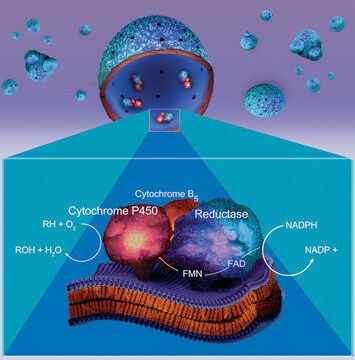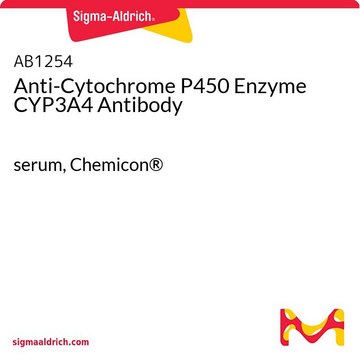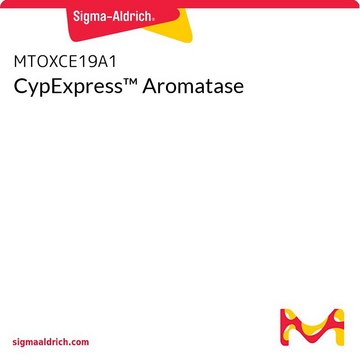MTOXCE3A4
CypExpress™ 3A4 Cytochrome P450 human
Synonym(s):
CP33, CP34, CYP3A, CYP3A3, CYP3A4, CYPIIIA3, CYPIIIA4, HLP, NF-25, P450 3A4, P450C3, P450PCN1
Sign Into View Organizational & Contract Pricing
All Photos(1)
About This Item
Recommended Products
biological source
human
recombinant
expressed in Pichia pastoris
form
dry powder
UniProt accession no.
application(s)
cell analysis
shipped in
dry ice
storage temp.
−70°C
Gene Information
human ... CYP3A4(1576)
Application
Poster: A Novel, Robust Recombinant Human P450 Biocatalytic System
Poster: Evaluation of Dry Powder Preparations of Permeabilized
Pichia pastoris Cells Expressing Human Cytochrome P450 2D6 Enzyme (CYP2D6) for Drug Metabolite Generation
Poster: Facile Scale-up Biocatalytic Production of P-450 Metabolites Using a Novel Recombinant Human Catalytic System
Poster: Multi-Cycle Production of Metabolites with human P450 systems
Poster: Rapid identifcation and production of metabolites using CypExpress™ 2D6m 3A4 and 2C9
Poster: Rapid identifcation and production of metabolites using stabilized dried powder (SDP) of human cytochrome P450S (hCYPS) 2D6, 3A4, and 2C9 engineered in yeast
Poster: Utilizing a Novel Biocatalytic Human P450 System for the Multi - Cycle Production of Metabolites
Poster: Evaluation of Dry Powder Preparations of Permeabilized
Pichia pastoris Cells Expressing Human Cytochrome P450 2D6 Enzyme (CYP2D6) for Drug Metabolite Generation
Poster: Facile Scale-up Biocatalytic Production of P-450 Metabolites Using a Novel Recombinant Human Catalytic System
Poster: Multi-Cycle Production of Metabolites with human P450 systems
Poster: Rapid identifcation and production of metabolites using CypExpress™ 2D6m 3A4 and 2C9
Poster: Rapid identifcation and production of metabolites using stabilized dried powder (SDP) of human cytochrome P450S (hCYPS) 2D6, 3A4, and 2C9 engineered in yeast
Poster: Utilizing a Novel Biocatalytic Human P450 System for the Multi - Cycle Production of Metabolites
Biochem/physiol Actions
Cytochrome P450 enzymes are heme containing monooxygenases which are found primarily in the mammalian liver. They catalyze the oxidative metabolism of xenobiotics. This metabolism is the initial step in the biotransformation and elimination of a wide variety of drugs and environmental pollutants from the body. Ketoconazole, itraconazole, azamulin, troleandomycin and verapamil are inhibitors, whereas rifampin is an inducer of the enzyme. The isozyme CYP3A4 is a major pathway for the invivo conversion of testosterone to 6β-Hydroxytestosterone via hydroxylation.
Cytochrome P450 is a heterogeneous family of isozymes whose primary function is to oxidize small molecules, both as a function of intermediary metabolism (e.g., fatty acids) and to detoxify exogenous compounds like xenobiotics, pollutants and drug molecules. Cytochrome P450 3A4 (CYP3A4) is one of the isoforms of cytochrome P450 (P450s). CYP3A4 oxidizes more than 90% of marketed drugs through various metabolic processes.
Features and Benefits
CypExpress™ 3A4 is a permeabilized and stabilized dried yeast powder preparation containing full length, unmodified, human CYP 3A4 and recombinant human NADPH oxidoreductase. Using proprietary processes, CypExpress™ are expressed in Pichia yeast. Following optimal expression, the cells are inactivated, permeabilized and dried to a fine powder. CypExpress™ retains the cellular mechanisms to provide the P450 enzymes with the energy and cofactors to continue to function for long experiments, and can generate larger amounts of metabolite than mammalian microsomes or other genetically engineered expression systems. It is designed for rapid screening of drug metabolites and for scaling up metabolite generation.
Unit Definition
A reaction mixture containing 500 μM testosterone and 100 mg/mL of CypExpress™ 3A4 will produce 121.9 μM 6b-hydroxytestosterone in 3 hours at 30°C under the conditions described.
Physical form
Light yellow, very fine powder
Reconstitution
Per Protocol/Variable
Legal Information
6538 is a trademark of American Type Culture Collection
CypExpress is a trademark of Oxford Biomedical Research
related product
Product No.
Description
Pricing
Storage Class Code
11 - Combustible Solids
WGK
WGK 1
Flash Point(F)
Not applicable
Flash Point(C)
Not applicable
Choose from one of the most recent versions:
Certificates of Analysis (COA)
Lot/Batch Number
Don't see the Right Version?
If you require a particular version, you can look up a specific certificate by the Lot or Batch number.
Already Own This Product?
Find documentation for the products that you have recently purchased in the Document Library.
Customers Also Viewed
Pharmacokinetic-pharmacodynamic consequences and clinical relevance of cytochrome P450 3A4 inhibition
Dresser, et al.
Clinical Pharmacokinetics, 38(1), 41-57 (2000)
Crystal structures of human cytochrome P450 3A4 bound to metyrapone and progesterone
Williams PA, et al.
Science, 305(5684), 683-686 (2004)
Maria João Gouveia et al.
Infectious agents and cancer, 14, 41-41 (2019-12-05)
Infections classified as group 1 biological carcinogens include the helminthiases caused by Schistosoma haematobium and Opisthorchis viverrini. The molecular mediators underlying the infection with these parasites and cancer remain unclear. Although carcinogenesis is a multistep process, we have postulated that
Maria João Gouveia et al.
Molecules (Basel, Switzerland), 24(21) (2019-11-17)
Infections caused by Schistosoma haematobium and Opisthorchis viverrini are classified as carcinogenic. Although carcinogenesis might be a multifactorial process, it has been postulated that these helminth produce/excrete oxysterols and estrogen-like metabolites that might act as initiators of their infection-associated carcinogenesis.
Our team of scientists has experience in all areas of research including Life Science, Material Science, Chemical Synthesis, Chromatography, Analytical and many others.
Contact Technical Service









